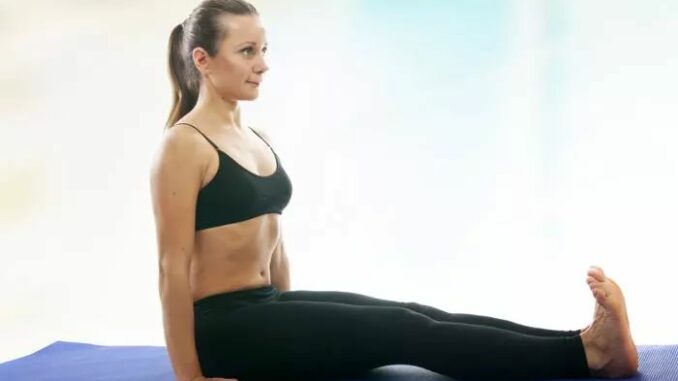
Introduction:
Sciatica, characterized by pain radiating along the sciatic nerve, can be a debilitating condition that affects daily life. While seeking professional medical advice is crucial, incorporating yoga into a holistic management plan can offer relief and promote healing. This article explores eight instant-relieving yoga asanas specifically designed to alleviate sciatic pain and discomfort. These gentle yet effective poses aim to stretch, strengthen, and bring balance to the body, providing a natural and accessible way to manage sciatica symptoms.
- Child’s Pose (Balasana):
- Begin on hands and knees, then gently sink the hips back towards the heels.
- Extend the arms forward, lowering the chest toward the mat and resting the forehead on the ground.
- Allow the spine to lengthen, feeling a gentle stretch along the lower back and hips.
- Breathe deeply, letting go of tension with each exhale.
Child’s Pose serves as an instant-relief posture, promoting relaxation and stretching the lower back and hips, areas commonly affected by sciatica.
- Pigeon Pose (Eka Pada Rajakapotasana):
- From a tabletop position, bring the right knee forward and place it behind the right wrist.
- Extend the left leg back, lowering the hips toward the mat.
- Square the hips and fold forward over the right leg, feeling a deep stretch in the outer hip and buttock.
- Hold the pose for several breaths before switching sides.
Pigeon Pose targets the piriformis muscle, often implicated in sciatic pain, providing relief by stretching and releasing tension in the hip region.
- Downward-Facing Dog (Adho Mukha Svanasana):
- Start in a plank position and lift the hips towards the ceiling, forming an inverted V shape.
- Ground the heels towards the mat and extend the arms, creating length in the spine.
- Feel a stretch along the back of the legs, hips, and lower back.
- Pedal the feet to further stretch the calves and hamstrings.
Downward-Facing Dog elongates the spine, stretches the hamstrings, and relieves tension in the lower back, making it beneficial for sciatica relief.
- Cat-Cow Stretch (Marjaryasana-Bitilasana):
- Begin on hands and knees in a tabletop position.
- Inhale, arching the back and lifting the head and tailbone (Cow Pose).
- Exhale, rounding the spine, tucking the chin to the chest (Cat Pose).
- Flow between these two poses, synchronizing breath with movement.
Cat-Cow Stretch promotes flexibility in the spine, releasing tension and improving mobility in the lower back, a crucial area for those experiencing sciatic pain.
- Seated Forward Bend (Paschimottanasana):
- Sit with legs extended in front, feet flexed.
- Inhale, lengthening the spine, and exhale, folding forward from the hips.
- Reach towards the feet, keeping the back straight.
- Hold the stretch, feeling a gentle elongation along the hamstrings and lower back.
Seated Forward Bend stretches the entire back body, providing relief to the sciatic nerve and promoting flexibility in the hamstrings.
- Supine Hand-to-Big-Toe Pose (Supta Padangusthasana):
- Lie on the back, extend the right leg towards the ceiling, holding the big toe with the right hand.
- Keep the left leg bent or extended on the mat.
- Hold the stretch, feeling a release in the hamstring and lower back.
- Switch sides after several breaths.
This supine pose allows for a targeted stretch in the hamstrings, promoting flexibility and alleviating tension along the sciatic nerve.
- Bridge Pose (Setu Bandhasana):
- Lie on the back with knees bent and feet hip-width apart.
- Press into the feet, lifting the hips towards the ceiling.
- Clasp the hands under the back and roll the shoulders underneath.
- Hold the pose, engaging the glutes and opening the chest.
Bridge Pose strengthens the back, glutes, and hamstrings while promoting flexibility in the spine, making it beneficial for sciatica relief.
- Legs Up the Wall Pose (Viparita Karani):
- Sit close to a wall, then lie on the back and swing the legs up against the wall.
- Keep the arms relaxed by the sides, palms facing up.
- Close the eyes and focus on the breath, allowing the spine to decompress.
Legs Up the Wall Pose is a restorative posture that promotes relaxation, reduces inflammation, and can provide relief from sciatica symptoms.
Conclusion:
Incorporating these instant-relieving yoga asanas into a comprehensive approach to managing sciatica can contribute to alleviating pain, improving flexibility, and enhancing overall well-being. It’s essential for individuals with sciatica to consult with healthcare professionals before starting any new exercise regimen, including yoga. With regular practice, these gentle yet effective poses empower individuals to take an active role in their sciatica management, fostering a sense of control, balance, and resilience on their journey toward healing.